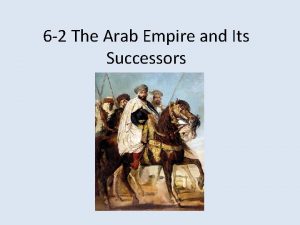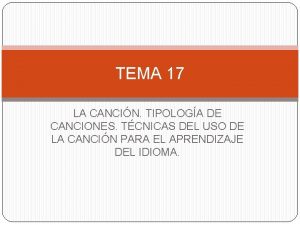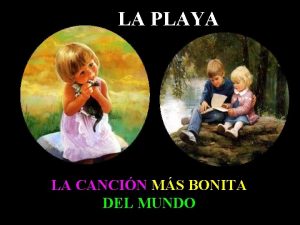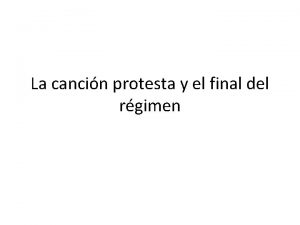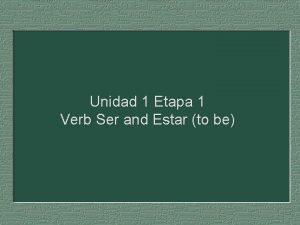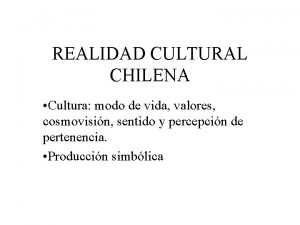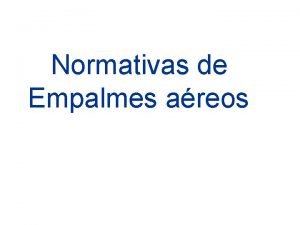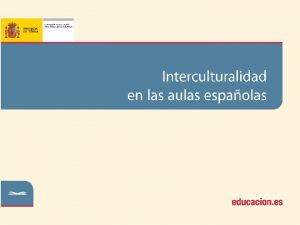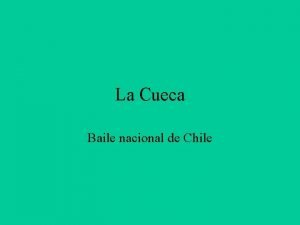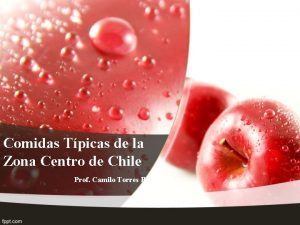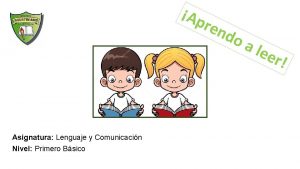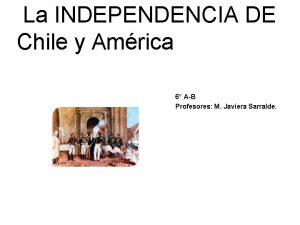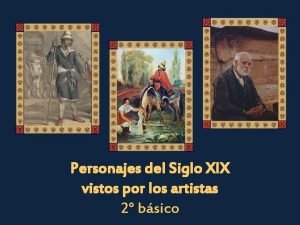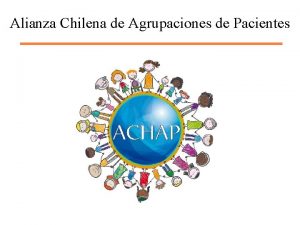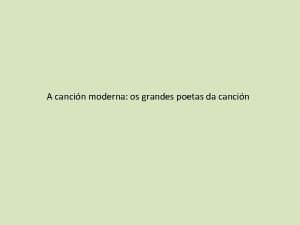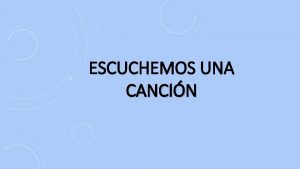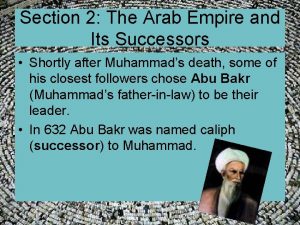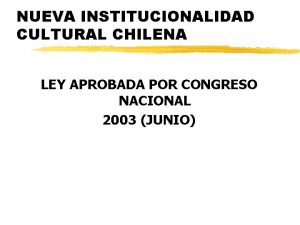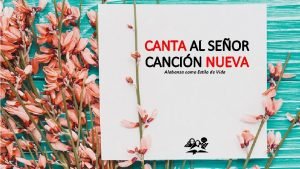Nueva Cancin and its successors Nueva cancin chilena












- Slides: 12

Nueva Canción and its successors

Nueva canción chilena � � � Movement began in Chile (Violeta Parra) and Argentina (Atahualpa Yupanqui) in the 1950’s. Partially a result of migration to urban areas, as well as ethnomusicological explorations (Parra) Characterized by use of regional folk melodies and instruments as well as socio-political subject matter. Songs are varied, and involve fusion of multiple styles (Andean, Spanish folklore, Cueca, Indigenous music) regularly featuring the guitar and South American wind or string instruments (quena, zampoña, charango) Arose as a pushback to Chilean radio stations preference for European and North American content. Was deeply involved in the Allende government, both sponsored by it and helped its election

Violeta Parra � � � � Grew up in Chillán, Chile Both parents played music, father Nicanor was a music teacher. Family played in nightclubs. (Boleros, ranchera etc. ) Encouraged by brother (Poet Nicanor Parra) to begin collecting folk music from all over Chile. Preserved over 3000 Chilean songs, proverbs and traditions. Eventually put her own lyrical and musical spin on traditional forms. Travelled to Europe twice promoting both folk music and artwork Popularized the practice of “peñas” or gatherings of politicized musicians and artists. Started La Peña de los Parra with son Angel and daughter Isabel. Established a cultural center in a tent “La Carpa de La Reina” which eventually failed. Is credited with initiating the Nueva canción movement in Chile with her recordings and promotional activities.

Víctor Jara � Born in Lonquén to a family of rural labourers. � Mother taught herself piano and guitar and performed folk music to supplement family income. � Later moved to Santiago and studied theatre at the University of Chile � Influenced by Parra and Yupanqui, performed regularly at Peña de los Parra. � Had a rich and varied career both as a soloist and composer/collaborator. � Was the artistic director for the group Quilapayún and contributed to some early music by Inti-Illimani. � Contributed to the Allende government and was later taken prisoner in the National Stadium and killed shortly following the coup.

Quilapayún � Name means “three beards” in mapudugdun. � Formed in 1965 by brothers Julio & Eduardo Carrasco � Advised and influenced by Angel Parra and Víctor Jara who was their music director between 19661969 � Songs integrated Chilean and other Latin American rhythms. � Was on tour in Europe during the 1973 coup, remained in France in exile. Continued playing and collaborating with other artists such as Roberto Matta. � Group changed members several times while in exile and eventually dissolved.

Inti-Illimani Founded in 1967 by a group of students at the Universidad Técnica del Estado (USACH) � Original founders included Horacio Durán, Pedro Yáñez and Jorge Coulón and later Horacio Salinas � Recorded in 1970 Canto al Programa putting to music the aims of the Allende government. � Released Viva Chile! In 1973 while in exile. Album contains hymns of the UP � Group was touring in Europe during coup, remained in Italy and continued recording. � Returned to Chile in 1988 to contribute to the “No” campaign. Recorded several albums afterwards which show changes in style (Incorporation of other Latin Music styles, Jazz, bolero etc. ) � Still tours, though as of 2004 group split into two with disputes over name. �

During the Dictatorship Because of Nueva Canción’s close relationship to the Unidad Popular, artists who weren’t killed (Jara) were censored or sent into exile. � Bowlderized versions of Nueva Canción music were sometimes available (free market), but performances were banned up until the mid 1980’s � “Canto Nuevo” started up in the 1970’s via underground peñas. Integrated pop, rock, jazz and electronic instruments and often featured members of defunct Nueva Canción groups. � More politically active peñas were also held by members of the Agrupación de Familiares de los Detenidos. Desaparecidos and other opposition groups starting in the late 1970’s and continuing into the 1980’s where Nueva Canción style continued to thrive. �

Cueca Sola � “Cueca” refers to a traditional Chilean dance, a pas de deux or couple’s dance. � The dance is said to imitate rooster and hens, male pursues, female evades. � Rhythms are quick, (6/4) with each “foot” containing 52 beats. Lyrics are in rhyming octosyllabic verses alternating with seguidillas. � Themes in cueca songs are usually romantic or “costumbristas” (artful poverty)

� Cuecas given political content through integration in “Nueva Canción”, ex. “Cueca de la C. U. T” � In 1979, Pinochet government legally declared the cueca as “Chile’s national dance” attempting to appropriate it as a folk expression of patriotism. � On International Women’s Day in 1978 a group of women from the AFDD held the first “Cueca Sola” in the Teatro Caupolicán in Santiago. (First mass-gathering in Chile since 1973) � “Cueca Sola” adapts traditional cueca and uses it as a form of protest.

� Women dance “Cueca Sola” without partners, wearing photos of disappeared loved ones. � Dress in black instead of floral traditional dress. � Lyrics of the original “Cueca Sola” song (Composed by Gala Torres, who gave shape to the performances) describe a woman whose beloved is gone. �En un tiempo fui dichosa �Apacibles eran mis días �Mas llegó la desventura �Perdi lo que más quería �Me pregunto constante �Dónde te tienen? �Y nadie me responde �Y tú no vienes.

� Cueca Solas began to be performed at AFDD protests and memorials. � Attacted the attention of international artists. Sting wrote a song about it (“They Dance Alone”) � The cueca thus transformed from a schema of “romantic conquest” to the scenification of grief and moving austerity. � At the same time the women turned Pinochet’s own patriotic narrative against him, articulating what the regime rendered unspeakable through his own language.

“Que dira el santo padre” Violeta Parra “Arriba quemando el sol” Manifiesto Plegaria a un labrador Victor Jara El pueblo unido Venceremos Cueca de la CUT Quilapayun Inti-Illimani Cueca sola No campaign
